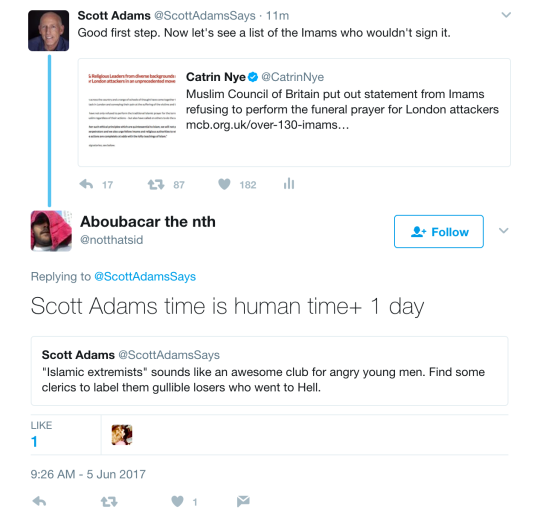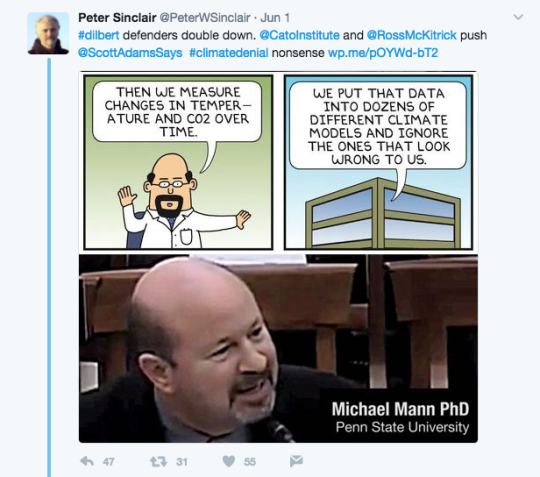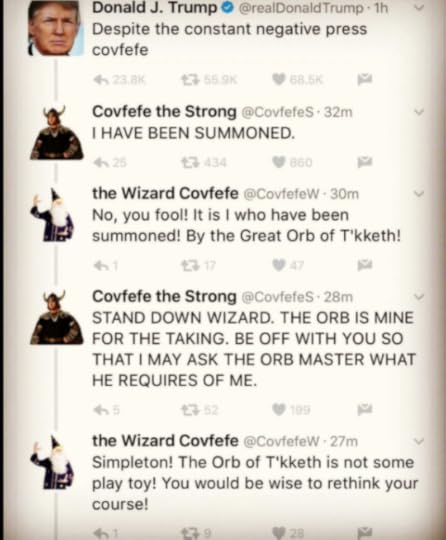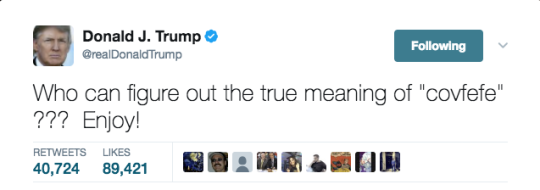Scott Adams's Blog, page 226
June 8, 2017
The Comey Fog
Ex-FBI Director Comey released a statement ahead of his appearance before Congress, and it has heads spinning. I’ll tell you how things look through what I call the Persuasion Filter.
There are several related stories swirling around the news that involve Russia, Trump, Trump’s campaign staff, and Comey. All together, the stories are beyond the capacity of the human brain to hold the details and keep them from automatically conflating in our minds and becoming more soup than individual ingredients. When you have this level of complexity, humans reflexively default to using bias over reason. Our capacity for reason isn’t up to the job in this case because all the Russia-Comey-Trump stuff has started to run together in our minds. We would happily use our limited powers of reason in this situation if we could, but the complexity of it all makes that a dream beyond our grasp.
Could a trained lawyer sort out this complexity and at least tell you whether or not a law has been broken? Apparently not. Otherwise the lawyers on both sides would agree. They don’t.
So what we are seeing is a super-clean example of what I call two movies on one screen. The anti-Trump media and citizens are peering into the Comey fog and seeing some serious Trump-related wrongdoing that is impeachable at the very least, and treasonous at worst. Meanwhile, Trump supporters are looking at the SAME FACTS and seeing nothing illegal except for some leaking by anti-Trumpers.
Now add to the Comey fog the recent news of how President Trump worded his conversations. The nation will be word-thinking like crazy today, trying to figure out whether “honest” and “hope” mean something. That’s just enough ambiguity to create confirmation bias in literally every observer. (Including me, of course.) We’re all seeing what we want to see at this point.
I’m not a lawyer, and I’m as biased as the rest of you on this topic. But for what it’s worth, I’ll tell you what I’m seeing through my filter.
“Honest Loyalty”
Comey reports that Trump asked him during a private meeting for “loyalty.” Comey promised “honesty” instead. When Trump pressed the point a second time, Comey said he would give “honest loyalty.” Trump agreed that “honest loyalty” is what he wanted. The way you interpret this conversation depends on whether you think Trump or his associates are guilty of anything. If you think Trump is guilty of a crime, the conversation sounds like a Mafia-style threat. But if you believe Trump and his associates are innocent of any crimes, you probably see honesty and loyalty as the same thing in this situation. Innocent people want law enforcement to be honest. For the FBI to act otherwise would be disloyal to both the Constitution and any citizens involved in the investigation. In the context of an investigation of an innocent citizen, honesty and loyalty from law enforcement are the same thing.
“Hope you can let it go”
Regarding the FBI investigation of Flynn, if you think there was wrongdoing by Flynn, Trump’s expression of hope that the FBI can “let it go” sounds like a gangster sending a threat. But if you believe Flynn was innocent of everything but lying to Pence (for which he was fired) then you see it as entirely reasonable that Flynn’s friend (Trump) would “hope” Comey could “let it go.” The alternative would be hoping that Flynn was harmed for no reason, and the government continued to be distracted over nonsense. Does anyone hope for that outcome?
I won’t defend what President Trump said or did on this issue. Clearly it was problematic because we’re discussing it instead of something more useful. But I don’t see a broken law.
Persuading Comey
Was President Trump trying to persuade Comey in any of their private conversations? Of course he was. In a political context, all conversations are about persuasion. Comey was trying to persuade Trump that Comey was a competent and capable player with no bias. Trump was expressing his preferences from a power position, which is persuasive by its nature.
Persuasion isn’t inherently good or bad. Persuasion is a tool. It’s goodness or badness depends on the context of its use. If you believe Trump knows he and his associates were innocent of any wrongdoing, and you observe that the investigations are making the government less effective, it feels entirely legitimate for the President to persuade in a direction that is a benefit for all citizens. No one wants to waste time, money, or energy on a useless investigation. But if you think there is some wrongdoing yet uncovered, presidential persuasion would be wildly inappropriate in this case, even if technically legal.
I haven’t seen evidence of any crimes on the Trump side, so my filter sees a president trying to remove some obstacles that are not serving him or the American public. That kind of persuasion doesn’t feel wrong to me.
If new information emerges, I’m happy to update my opinion.
—
You might enjoy reading my book because I it is chock-full of honest loyalty.
I’m also on…
Twitter (includes Periscope): @scottadamssays
YouTube: At this link.
Instagram: ScottAdams925
Facebook Official Page: fb.me/ScottAdamsOfficial

June 7, 2017
Solar Panels on the Wall?
Axios is reporting that President Trump suggested putting solar panels on the new Wall with Mexico. The article wonders where the idea came from:
Where this idea might come from: A proposal to cover the wall with solar panels was among those submitted when the U.S. requested designs earlier this year, according to the AP. Companies winning contracts and asked to build prototypes may be announced this month.
That’s one place it might have come from. But I consider it an obvious idea, which means the President might have come up with it himself. And when I say “obvious,” I mean it is obvious to people who understand the power of persuasion.
Case in point, consider this quote from my blog post in November of 2015, about a year before the first Wall bids were submitted.
Now let’s keep thinking big about what this “wall” actually is. I can imagine a bullet train operating inside the wall, with shops and entertainment on each side, at least within the gateway city. I can imagine solar panels all along the top. I can imagine condos built into the wall. You can add more ideas. The point is that “wall” is thinking small. Think gateway city.
You can see the rest of that blog post here.
Many readers of this blog have wondered about the spooky accuracy of my Trump-related predictions for the past 2 years. Some have wondered on social media if I was somehow causing things to happen or just doing a good (or lucky) job of predicting. I’d like to propose a third option: People who understand persuasion think alike.
Putting solar panels on the wall is persuasion. It isn’t construction. It isn’t politics. It isn’t border security. It isn’t climate protection. It is pure persuasion. If that isn’t already obvious to you, consider how hard it would be for critics to argue against a green energy project, even if that is just an add-on feature to the wall. It changes the frame.
My hypothesis is that people who understand persuasion are likely to come to similar conclusions about things, and those conclusions will not agree with 98% of the public. Want more evidence of that? Take a look at linguist and persuasion expert George Lakoff’s take on President Trump’s Twitter strategy. You’ll see it is similar to what I’ve been telling you for a few years now. That’s not a coincidence. Lakoff is looking at the situation through what I call the Persuasion Filter, same as me.
We all have our own filters, informed by our training and life experiences. People who only know politics see only politics. People who are trained only in economics will tell you to follow the money. And trained persuaders will tell you persuasion is usually the predictive variable.
When you see experienced “persuaders” agree on a topic, it doesn’t mean one of them got the idea from another. It probably means there was one obvious persuasion-related play and those with training recognized it at the same time.
—
You might enjoy reading my book because it is almost summer.
I’m also on…
Twitter (includes Periscope): @scottadamssays
YouTube: At this link.
Instagram: ScottAdams925
Facebook Official Page: fb.me/ScottAdamsOfficial

June 5, 2017
Most Problems are Information Problems
I have a hypothesis that nearly all solvable problems in the modern world are information problems in disguise. For example, unemployment is largely (but not entirely) a problem of people not knowing where to find jobs, as opposed to no jobs existing. I could give you lots of other examples where information would solve a major problem, but today I want to focus on one: Stopping terrorism.
Terrorism is an information problem in the sense that if we knew where to find the terrorists, we could stop them. But it is also an information problem in a few other ways. Take this example:

Imagine having the information about which Imams in Britain WOULD do a funeral prayer for a terrorist who murdered British citizens. Call me an optimist, but I think that information would help the British public sort things out.
We’re almost there.
—
You might enjoy reading my book because most problems are information problems.
I’m also on…
Twitter (includes Periscope): @scottadamssays
YouTube: At this link.
Instagram: ScottAdams925
Facebook Official Page: fb.me/ScottAdamsOfficial

June 4, 2017
Helping the Terrorists Recruit
There is more terrorism in the news, this time in London. So how do the British politicians respond?
They do a recruitment ad for more terrorists.
They start by giving the terrorists cool labels, such as “Islamic extremists.” Do you know what sounds like an awesome club for an angry young Muslim to join? I’m thinking “Islamic Extremist” sound about right. That branding should be great for recruitment.
The media also helps terror recruitment with their wall-to-wall news about the terrorists’ successes. Every time they mention the body count, the bad guys cheer.
A better approach for the media, if they want to be helpful, might involve inviting a continuous line of Muslim scholars and critics to talk about how these “gullible losers” were duped by ISIS to kill themselves and spend eternity in Hell. And we need lots of visual and other persuasion about Hell. I want Photoshopped images of the terrorists burning for eternity. I want descriptions of the smells, tastes, and sounds they are experiencing, so the next “lone wolf” has something to contrast with the 72 virgin story. Let’s put some doubt into that mix. Fear is a good persuader.
I also wonder why the families of terrorists are not being flooded with condolence messages from Muslim clerics saying they are sorry about their kid burning in Hell for eternity. Be sincere about it. Include some digital representation of Hell in those cards and letters.
Change the frame.
—
You might enjoy reading my book in the safety of your home because traveling is dangerous.
I’m also on…
Twitter (includes Periscope): @scottadamssays
YouTube: At this link.
Instagram: ScottAdams925
Facebook Official Page: fb.me/ScottAdamsOfficial

June 3, 2017
An Example of Cognitive Dissonance
What the heck is “climate denial”? Is that even a thing?
I mentioned on Periscope the other day that I created a Sunday comic as a cognitive dissonance trap. I wanted to see if I could make an argument about the reliability of ECONOMIC models and dupe irrational people into labelling me a climate denier.

As you can see below, the experiment worked as planned. Notice the excerpt below leaves out the part of the comic that mentions ECONOMIC models.

I know many of you don’t believe I planned this as a cognitive dissonance trap. But I did. If I do something like this again, I’ll call it out for you in advance so you can follow the experiment.
My hypothesis (to myself) was that i could make a public argument about the reliability of ECONOMIC models, and partisans on the climate debate would not be able to see the word ECONOMIC on the page. Literally.
If you see the word ECONOMIC in the comic (twice), you probably can’t find anything objectionable about the point of it. Both sides of the debate would agree that you need an economic model to make a decision. And both sides would agree that no such credible model exists.
Science tries to tell you what is true, as best it can. Economics tells you how one true thing COMPARES to another true thing on cost. Those are very different models. For example, science might tell you the sea level will rise by three inches. But you need an economic model to decide whether spending money to address that problem is better than spending money to fix other problems. If you leave out the other options for spending your limited money, you have done no decision-making analysis whatsoever.
No scientist would disagree with what I just said. Likewise, no scientist who sees the word “ECONOMIC” in my comic would find anything with which to disagree. The only way you can disagree with the comic is to (literally) hallucinate that it says something other than what it says. And that’s what happened. As I predicted.
The trigger for cognitive dissonance is this:
1. Climate scientists are 100% sure they are right.
2. My comic explains that no credible decision-making models (economic models) exist.
3. Climate scientists reading my comic realize they haven’t done the work necessary to make their case to the public because science is only the first step. Economics is the tool you need for policy-setting and decision-making. And the economics of climate change – which would necessarily compare all spending options for our limited money – haven’t been modeled in any credible way.
4. Given this set-up, a climate scientist would either need to admit that his or her career-defining opinions about climate policy are incomplete (at best), or the scientist must spontaneously generate an illusion that masks the words ECONOMIC in my comic. In other words, climate alarmists experiencing a state of cognitive dissonance can read that comic ten times and not remember seeing the word ECONOMIC when done. I mean that literally. The word ECONOMIC will be mentally invisible to anyone in this cognitive dissonance trap.
Try showing this comic to a climate alarmist friend and see how well the trap works. Look for your friend to fight like a wounded weasel to avoid talking about ECONOMIC models. And watch how quickly you get labelled a “climate denier.”
As if that is even a thing.
Enjoy.
—
You might enjoy reading my book because science.
I’m also on…
Twitter (includes Periscope): @scottadamssays
YouTube: At this link.
Instagram: ScottAdams925
Facebook Official Page: fb.me/ScottAdamsOfficial

June 2, 2017
Betting on Climate Change
Did you notice the stock market rising sharply after President Trump announced he would pull out of the Paris Climate Accord and – according to CNN – destroy the entire planet? Markets are irrational, but still, it’s hard to reconcile a decision to destroy civilization with a rise in investor confidence.
What should I make of the fact so many citizens say global warming is an existential danger while the people who have money are (apparently) betting against it? How does that make sense?
One way it makes sense is that markets move for lots of different reasons. But in my experience, a sharp move in the markets timed to a political action is like an instant vote of thumbs-up or thumbs-down on the decision. Apparently, leaving the Paris Accord was a thumbs-up for investors.
And so I give you this hypothesis: There is social pressure to say you side with the majority of climate scientists. To do otherwise would make many people feel like ignoramuses. So they craft their personalities around a belief in climate change doom because they are people who respect science. It fits their identity preference.
Until you ask them to invest their money.
Then people bet against it.
Here I’m not talking about every person. I’m talking about a tendency for some members of a group to be frictionless-only members. As soon as you give them friction – such as a financial risk – some (not all) climate alarmists might become climate skeptics.
That’s just a hypothesis.
Another hypothesis is that markets are short-sighted. But how much short-term benefit does the entire economy get from leaving the Paris Accords? I haven’t seen the argument for it helping directly in the next quarter or two, except in terms of optimism for the long-term.
And yet another hypothesis is that the people who have extra money to invest have a different view of climate risks than people who don’t have money. And that could be because the investor class is either smarter or dumber on this topic, on average, than non-investors.
All of this makes me wonder why there isn’t a more robust betting market for climate change predictions. Folks could bet on sea level changes and temperature averages using some agreed standard for measurement. That way, the climate alarmists can hedge against the economic catastrophe they see coming, at least for their own families. Given the certainty of climate scientists, I would think the people betting on their side would be making easy money. Those winnings could help offset the higher expenses caused by climate disruption.
Apparently, bad versions of the betting market idea already exist, or did exist at one time. I’m sure you’ll tell me about others. But the lack of a big-time betting market in this space tells me there wouldn’t be enough bets on one side of the topic to make a market.
I wonder which side that would be.
Disclosure: My current view on climate science is that the climate scientists are probably right on the basic science, and their climate models are probably directionally right too. But no one has created a credible economic model around climate change. Until you have a long-term economic model that you can trust, you have no way to know what to do about climate change or when to do it. The climate science models don’t tell you any of that. They aren’t designed for that. If you want to make rational decisions about climate change economic risks, you need credible long-term economic models, not climate models.
On a related note, there’s no such thing as a credible long-term economic model. It isn’t a thing.
—
You might enjoy reading my book because the alternative is drowning in iceberg water and polar bear tears.
I’m also on…
Twitter (includes Periscope): @scottadamssays
YouTube: At this link.
Instagram: ScottAdams925
Facebook Official Page: fb.me/ScottAdamsOfficial

May 31, 2017
The Kathy Griffin Controversy
Comedian Kathy Griffin got into some hot water for a staged photo of herself holding a realistic-looking severed head that looks like President Trump. I won’t reproduce the photo here. It is disturbing. People asked me what it all means in terms of persuasion, if anything. I’ll tell you.
Disclosure: Kathy Griffin played the voice of the Alice in my old Dilbert TV show on UPN. I like Kathy, both personally and professionally. I’m a fan. Feel free to factor in my bias when you read this post.
The fascinating part of the story is that Griffin and at least one photographer thought this photo would be provocative but within bounds. The Internet quickly informed them they were wrong. Griffin issued a video apology that some people judge to be insincere. But it looked 100% sincere to me.
I have been telling you since before the inauguration that the country was going to split into two movies on one screen. Some of us are watching a new president do his best to make America great. But half the country is watching a disaster movie in which we unknowingly elected a Hitler-monster to destroy civilization. The Kathy Griffin situation illustrates the two-movie idea perfectly. For Kathy and her associates at the photoshoot, this photo was intentionally provocative, but in a silly way. In their movie, beheading the Hitler-monster is a widely-approved fantasy. Perfectly acceptable. Nothing to see here.
Then they published the photo.
And learned there was another movie on the same screen.
You and I get to live in the movies in our heads until your script and mine come into conflict. That’s what happened with the Griffin photo. The photo showed us with disturbing clarity that we are not experiencing the same movie. In some of our movies, Griffin literally took the side of ISIS (EviLosers) against the Commander in Chief of the United States. But in Kathy’s movie, a comedian made a provocative joke, as she often does. That’s all.
Obviously I support Griffin’s right to produce provocative and sometimes offensive art. That is part of her job. And I also respect her rapid and thorough apology. To feel otherwise about Kathy would make me one of the overly-sensitive folks I have been mocking for years. You don’t get to turn me into that person. But you can go full-snowflake on this topic if you like.
The takeaway here should not be so much about Griffin. The takeaway is that a room full of people involved in the photoshoot did not see this as a huge problem from the start. They were living a different movie. If you judge this situation to be an error of taste, judgement, intelligence, or morality, you are missing the bigger picture. The bigger picture is that the country is living two movies at the same time, and Griffin was acting “normal” in one of them.
Persuasion-wise, Griffin’s photo was so over-the-line that I assume it ruined the movie for a lot of people following the anti-Trump script. The audience in Griffin’s movie just had a mirror held up to them. If they liked what they saw, they will stay in their seats. If they don’t like being the villains in their own movie, they might change the channel.
History might record this as the beginning of Trump’s rise in popularity. I have been predicting you will see the rise in the polls by year end.
Do you consider Kathy Griffin’s disturbing photo to be “art”? That’s a purely subjective evaluation. But Griffin did turn most Trump supporters into hypocrites by making them complain about political correctness.
If that isn’t art, you don’t know art.
—
You might enjoy reading my book because of all the art that isn’t in it.
I’m also on…
Twitter (includes Periscope): @scottadamssays
YouTube: At this link.
Instagram: ScottAdams925
Facebook Official Page: fb.me/ScottAdamsOfficial

Covfefe
By now, most of you know President Trump tweeted an unfinished message including a funny typo with the nonsense word “covfefe” late last night. He kept the tweet posted for hours while the Internet had its fun.

My hypothesis is President Trump was composing a tweet and got interrupted. Maybe he stuck his phone in his pocket and “pocket-tweeted” the typo. In any event, it was clearly accidental, as well as delightfully human.
The magic of the tweet is that covfefe is an astonishingly funny word. You couldn’t invent a funnier word if you assembled a panel of humorists and experts. But as I say, it was an accident. I also often say, “Creativity is allowing yourself to make mistakes. Art is knowing which ones to keep.”
President Trump apparently decided to leave his typo-tweet live for hours, as the Internet went wild with delight. If you are a Twitter user, you saw some of the best humor of the year happen late last night and this morning.
The typo was just a mistake. But the President’s decision (I assume) to keep it posted for hours was a smart move. In movie terms, he created what writers call a “trap door” in the script. The trap door is the laugh that gives you some relief in a scary or dramatic movie. The country needed a laugh. Trump saw the opportunity created by the typo and wrote it into the script. Nicely done.

—
You might enjoy reading my book because covfefe.
I’m also on…
Twitter (includes Periscope): @scottadamssays
YouTube: At this link.
Instagram: ScottAdams925
Facebook Official Page: fb.me/ScottAdamsOfficial

May 24, 2017
Going After the Families of Terrorists
During the presidential campaign, President Trump famously suggested going after the families of terrorists. That would be strong persuasion. The downside is that it is also a war crime. So Trump backed off on “going after the families.”
Or did he?
On his overseas trip, Trump demanded that the Palestinians stop paying the families of dead terrorists. The president is literally “going after the families” without firing a shot.
President Trump is also “going after the families” by branding ISIS as Evil Losers. You might be proud of your son for being a Jihadist, but the Evil Loser brand isn’t bringing anything good to the family name.
Let me give you a little thought experiment. Suppose our military found a terrorist bomb-maker who supplied bombs and training to terrorists but never did a terrorist act himself. Would we be within our military, legal, and ethical boundaries to kill that bomb-maker with a drone attack?
I think all of you just said yes.
In the context of a suicide bomber, the “bomb” is two parts. One part is the human being, and the other is the mechanical/chemical bomb. The bomb-maker made the mechanical/chemical part. But the family of the terrorist might have created the rest of the bomb, at least in some cases.
So here’s the thought experiment. In the specific case where a family radicalized their own kid, and also accepted payment after the suicide attack, is that really different from being a “bomb-maker”? After all, the kid is an important part of the bomb.
In some cases, if not most, the family has no real control over the actions of an adult child radicalized on his own. If you attack that family, you are committing a war crime for sure. That would be evil. And it would be hard to determine how much the family did to radicalize the kid.
Realistically, there is no practical way to go after the “bomb-maker” families without accidentally killing some innocent people who were minding their own business. To avoid that situation, you would need some clear, objective standard for deciding which families are “bomb-makers.” One such standard might included the family accepting the money AND making a public statement supporting their terrorist kid’s actions.
You probably don’t want to attack a family simply because they accepted free money when offered. In a poor region, people don’t say no to free money. But if the family also makes a public statement in favor of terrorism, they are literally attempting to create more (human) bombs by popularizing the concept.
I’m not in favor of Americans committing war crimes. But I’m okay with killing bomb-makers. Apparently I can’t have both.
—
You might enjoy reading my book because it has nothing to do with my blog topic today.
I’m also on…
Twitter (includes Periscope): @scottadamssays
YouTube: At this link.
Instagram: ScottAdams925
Facebook Official Page: fb.me/ScottAdamsOfficial

May 23, 2017
The Time I Nudged Climate Scientists into Debunking their Own Models
If you have been reading this blog and following me on Periscope, you know I announced I was going to use my own powers of persuasion to nudge climate scientists into doing a better job of communicating their side of things. The climate models are the least-credible thing scientists do, and yet scientists have been using their models as their featured evidence. No matter which side you are on with the climate change debate, you don’t want either side using their weakest argument. You want both sides to do their best so we can accurately judge who has the strongest thinking. To that end, I framed the “climate models” as being necessarily incomplete because you really need economic models to decide how to react to climate change, not scientific models. And long-term economic models have zero credibility. Even scientists would agree on that point.
Evidently I applied enough persuasion to generate this video that attempts to debunk my debunking of climate models. But it does so by…devaluing their own models. That’s what I was trying to do too. We’re on the same page.
Watch the clip for the Absurd Absolute tell for cognitive dissonance that happens at ten seconds in. The scientist defines the opposition argument with the absurd absolutes “anything” and “everything.” Whenever you see your opposition create a strawman argument with absurd absolutes, it means you won the debate. You only see this behavior when the opposition has no response to your real argument; they have to transform it into an absurd absolute in order to have any response at all.
I told you I was going to rewire this global debate exactly this way. I did this as a demonstration of the power of persuasion.
Now, do you still think President Trump’s branding of the Losers is just name-calling?
It isn’t.
—
You might enjoy reading my book because of persuasion.
I’m also on…
Twitter (includes Periscope): @scottadamssays
YouTube: At this link.
Instagram: ScottAdams925
Facebook Official Page: fb.me/ScottAdamsOfficial

Scott Adams's Blog
- Scott Adams's profile
- 1259 followers



